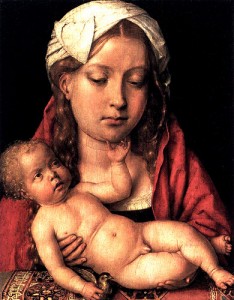
On 31st January 1510, Catherine of Aragon’s first pregnancy ended with her going into premature labour and giving birth to a stillborn daughter. It was obviously a devastating blow to Henry VIII and Catherine of Aragon and what made the situation harder was that Catherine’s abdomen continued to swell and her physician advised that she was still pregnant with the twin of the baby she had lost.
The royal couple clung on to this hope, even when Catherine began to menstruate again. The royal nursery was prepared, Elizabeth Denton, the former Lady Mistress of Henry’s own nursery, was brought out of retirement in anticipation of the birth, and Catherine entered her confinement in March 1510. She never went into labour, there was no baby, and it appears to have been a phantom pregnancy. It must have been like losing a baby all over again.
Catherine quickly became pregnant again and on 1st January 1511 she gave birth to a baby boy, Henry, Duke of Cornwall. Sadly, the little prince lived only 52 days, dying on 22nd February 1511.
There is evidence for Catherine having six pregnancies:
- 31st January 1510 – A stillborn daughter born 33 weeks after the marriage. This is reported by Diego Fernandez, Catherine’s chancellor, in the Calendar of State Papers (Spain)
- 1st January 1511 – Birth of a son, Henry, who died on 22nd February at just 52 days old.
- 17th September 1513 – Birth of a son who was either stillborn or who did not survive long. The Venetian Calendar of State Papers records that the child was alive at birth: “a male heir was born to the King of England and will inherit the crown, the other son having died.”
- November 1514 – The Venetian ambassador, wrote to his senate in November that “The Queen has been delivered of a stillborn male child of eight months to the very great grief of the whole court”, Holinshed, the chronicler, reported that “in November the Queen was delivered of a prince which lived not long after”, and John Stow wrote “in the meantime, to Whit, the month of November, the Q was delivered of a prince which lived not long after”.
- 18th February 1516 – Birth of a daughter, Mary, the future Mary I.
- 10th November 1518 – Birth of a stillborn daughter. The Venetian ambassador wrote “The Queen has been delivered in her eighth month of a stillborn daughter to the great sorrow of the nation at large”.
As you can see, Catherine lost babies through stillbirth rather than miscarriages, as is usually claimed. It must have been heartbreaking for her to lose all those babies and cope with all the pressure that was on her to provide Henry VIII with a son and heir.